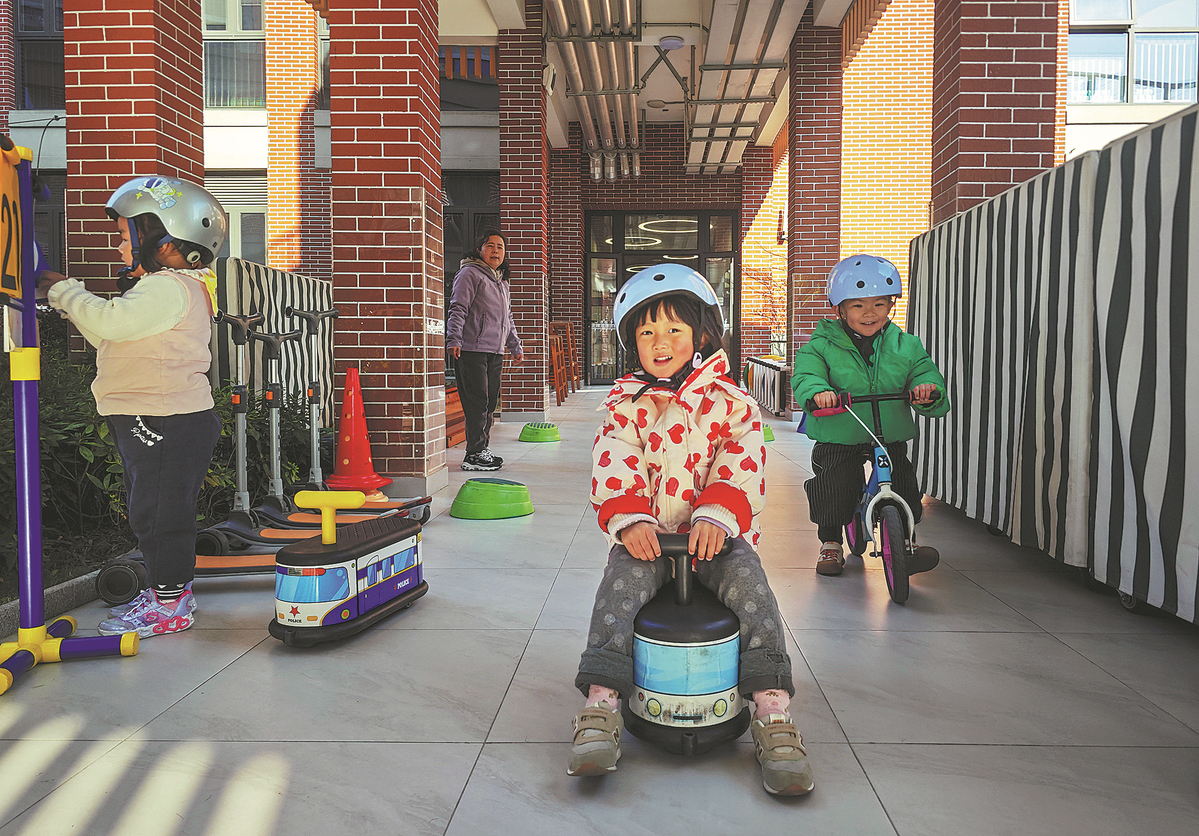
Children engage in outdoor activities at a kindergarten in Shanghai's Putuo district on Dec 24. [Photo by Tao Lei/For China Daily]
Shanghai has made progress in expanding access to public and inclusive preschool education while raising quality standards, according to the recently released 2024 Blue Book on High-quality Kindergarten Development in Shanghai.
The report, unveiled on Tuesday, highlights significant advancements in the city's early education landscape. By the end of 2024, public kindergartens in Shanghai accounted for 84.3 percent of total enrollment, a 4 percentage point increase from the previous year. Coverage of inclusive kindergartens also improved, reaching 94.1 percent, up by 1 percentage point.
Indicators of educational quality showed positive trends, with professionally trained teachers making up 99.3 percent of the workforce. Additionally, 98.3 percent of kindergarten classes met standard size requirements, reflecting a commitment to optimal learning environments.
To further improve early childhood education, Shanghai added 5,155 new public nursery class positions and 9,034 community child care slots last year, achieving nearly full coverage of community-based nursery services across the city. The city's child-development-first approach was also evident in the completion of 494 space renovation projects aimed at enhancing outdoor activity areas in kindergartens.
Shanghai has also established 105 kindergarten groups and 39 school districts, allowing for the flexible deployment of more than 2,100 educational personnel to ensure a more balanced distribution of resources.
"These statistics reflect Shanghai's focus on improving the quality of early education while strengthening infrastructure," said Xu Shiqiang, director of the General Education Department of the Shanghai Academy of Educational Sciences, in an interview with Shanghai Education TV Station.
In addition to ensuring favorable admission conditions, the city aims to enhance the quality of child care and education, Xu said.
While Shanghai's initiatives have led to a 15 percent increase in outdoor activity time for children in kindergartens, a recent study indicates that further improvements are needed in the promotion of physical activity levels outside school hours. Despite preschoolers averaging 99 minutes of outdoor activity during school hours, after-school physical activity falls below recommended levels, with only a portion meeting national standards.
On average, Shanghai's preschoolers engaged in 51.5 minutes of after-school physical activity on weekdays and 121.2 minutes on weekends. These figures fall short of World Health Organization guidelines, which recommend at least 180 minutes of daily physical activity for preschool children, including 60 minutes of moderate to high-intensity exercise. Chinese national guidelines similarly suggest 180 minutes of cumulative daily physical activity, with at least 60 minutes at moderate or higher intensity and 120 minutes of outdoor activity.
Physical activity includes leisure activities, sports and various forms of exercise, explained Jiang Fan, publisher of the study and deputy Party secretary at Shanghai Jiao Tong University.
"Our data shows considerable room for improvement," Jiang said.
In response to these findings, the Shanghai Municipal Education Commission plans to implement digital tracking systems to monitor outdoor activities in kindergartens, emphasizing the importance of physical activity alongside regular health checkups.
Parents such as Zhang, whose child attends a kindergarten with good outdoor facilities and strong safety measures, praised the city's efforts in promoting physical wellbeing among children through structured outdoor activities and monitoring systems.
"In my kid's kindergarten, two hours of outdoor activities are guaranteed daily during school hours," Zhang said.
For overweight and physically weak children, real-time monitoring bracelets allow teachers to track vital signs, she added.